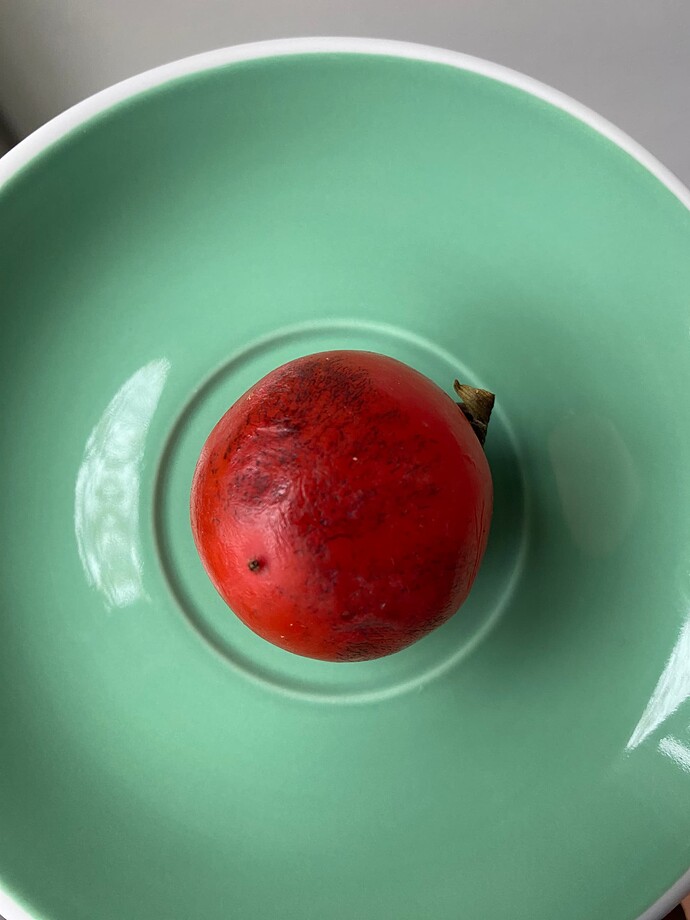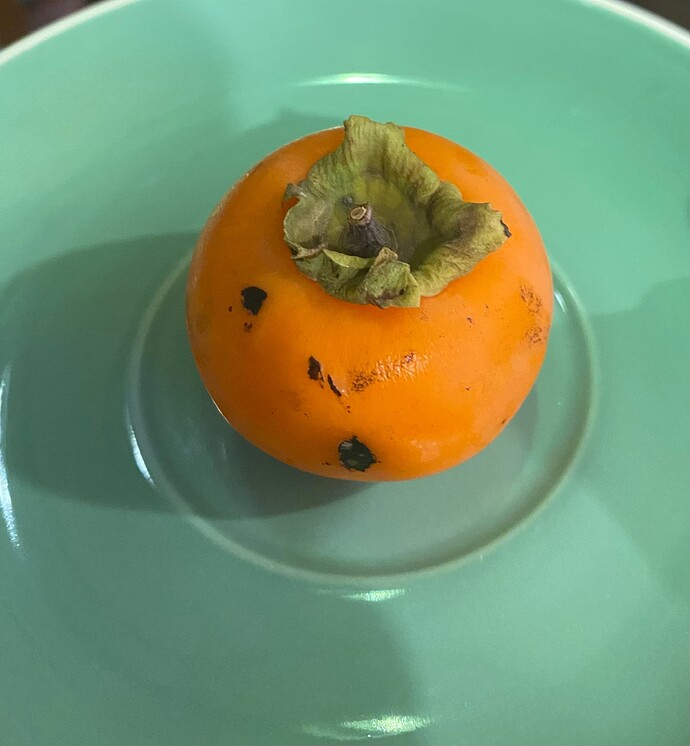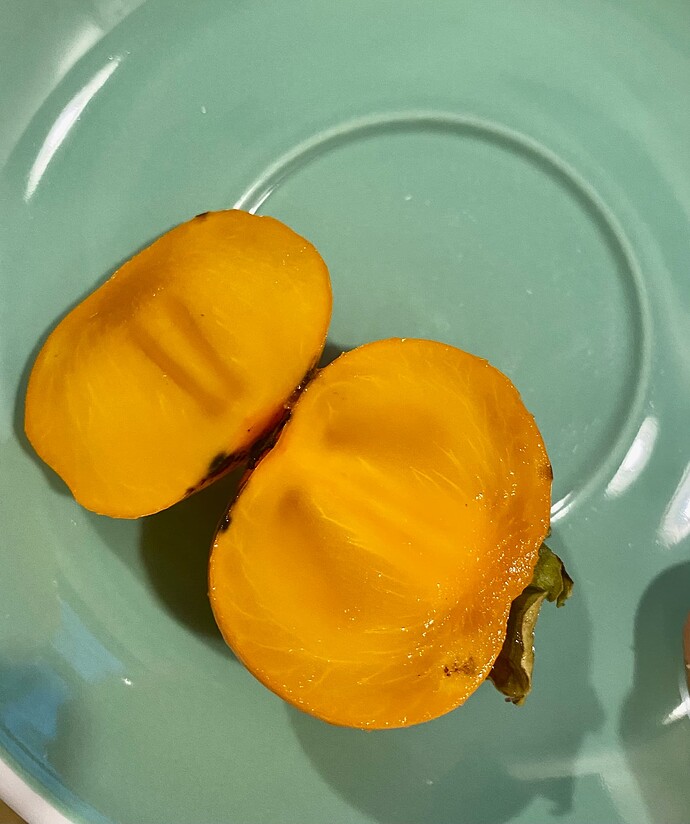All of mine happened at the nursery. Got 4-5 stone fruits like that. The odd thing was the rootstock fruit was not that bad. When that happens though it will still look like it has been grafted because it was cut. So there is no way to know till it fruits.
This is a final call on tastings of H63A, Barbra’s Blush and Dollywood this season. Note that the fruits come from the first crops produced by last year’s grafts. Note also that there was a late frost (May 9-10) that seems to have delayed the season. H63A and Barbra’s Blush ripened mostly in mid to late October. Dollywood ripened some fruits in late October but most of the crop is still unripe on the tree in early November.
H63A is the winner. The fruit has a shiny, flawless skin. It hangs well on the tree and can be picked non-astringent. A fruit that feels soft to the touch (without having to have become a misshapen, discolored mess) is generally either non-astringent or only slightly astringent. The flavor is sweet, though not intensely so, and rich. My tentative strategy for picking this variety is to let it ripen fully on the tree, pick it by cutting the stem, then give it 1 day on the kitchen counter.
Barbra’s Blush is a close second. The ripe fruit has more of a matte finish, again flawless. It hangs well but tends to drop when ripe, pulling off at the calyx. A fruit that is soft to the touch but still on the tree is generally still slightly astringent. The flavor is sweet, similar to H63A, and persimmon-y but more mellow than H63A. One is slightly sharp, the other very smooth. My tentative strategy for picking this variety is to pick it soft but not quite ripe as I’d much prefer to have the calyx attached. So I’d cut the stem, then give it 2-3 days on the kitchen counter.
Dollywood is a more distant third but it may not have gotten a fair chance, given the delayed season. It has a shiny skin that is sometimes flawed. The flavor is sweet and mellow but less intense than the others, at least in this sampling. Again I think I’d prefer to pick them soft before dropping and let them ripen 2-3 days on the kitchen counter.
Note that these results are a striking contrast to my struggle with the rootstock tree, which was sold to me as Prok. Those fruits tend to ripen throughout October and early November. Taste is highly variable but not generally especially sweet or flavorful. They drop from the tree by separating at the calyx. Any fruit still attached to the tree is usually still highly astringent. I’ve tasted a bunch of these this year. On the average they have been slightly better than I remember but the problems persist. I plan to remove almost all rootstock (or maybe technically inter-stock) wood from the upper section of the tree.
For comparison, my Kassandra fruits on an established stand-alone tree are well colored but still quite hard. They are ripening later than last year, even though there are fewer. A few damaged fruits ripened early, and I have to say that I found them superior to the Americans. The flavor was sweeter and more intense. But I’m going to taste the rest before I make a final judgment. I’ll let them stay on the tree a bit longer as temperatures are still 50’s during the day and above freezing at night. It was 33 F a few nights ago.
My JT-02 fruit, on a 2-year old graft on the “Prok” tree, are slowly coloring but still show a blend of green and orange. I’ll let them sit on the tree as long as possible but I think it’ll take time inside to ripen them. I’ll most likely pick them whenever a hard frost is forecast. Last year I picked my last IKKJ around Nov 15 but they were already solid orange though still not fully ripe. That worked fine. Stay tuned for a tasting.
Thanks for this detailed taste report. This is consistent with my observations as well - in general hybrids are a bit sweeter but later.
Are you still just as enthusiastic as earlier about PCNA hybrids now that you tasted well ripened PCA persimmons?
If you have room, I recommend H118. I quite like its intense flavor. This is commonly available and maybe because of that, it doesn’t get as much love. But it is my favorite American persimmon.
H63a is smoother, equally sweet but less intensely flavored.
Across all my persimmons, JT02 and Nikita’s gift are perhaps my favorites with a slight edge to NG — maybe because it is more mature.
Morris Burton has been a disappointment this year. Fruit size is small and very little flavor.
But it is a very small young tree and hopefully will improve.
All my persimmons were astringency free when ripe to my taste. I did have one person slightly complain about my h63a at a fruit tasting but he might have been very sensitive to even trace astringency.
Just went out to check my Rosseanka. Orange, but still hard.
All of you describe these hybrids as sweeter and more intense. Is that more intense american flavor or something else?
No, just sweeter in my experience. American have a better flavor but hybrids seem sweeter to me when tasted side by side.
I don’t see any reason not to be enthusiastic about a possible PCNA hybrid. The goal is to combine the non-astringency of a PCNA with the extra flavor of the PCA parent. Losing the astringency does not seem to require losing the PCA flavor. As if to prove the point, you mention above that JT-02 is your favorite (or narrowly 2nd favorite) persimmon. It is 1/2 PCNA. All we have to do is slip in another 3 NA alleles! ![]()
Also there is the texture issue. Most of the people I know prefer a firmer texture, though I don’t care so much. A hybrid PCNA would presumably be edible while still somewhat firm.
I had noticed your reviews (and others) of H118 / Early Jewel / Prairie Star. I ordered a tree a few days ago.
I’m sorry to hear your disappointment with Morris Burton. This year I went through the trouble of grafting it to two branches of my “Prok” rootstock tree, joining the others. I was responding to some rave reviews of flavor coupled with reports of an early loss of astringency. The grafts all grew beautifully. I should get fruit next year. I won’t mind small fruit but mediocre flavor will be a bummer.
You mean parthenocarpic I think… I hadn’t heard of parthenogenic and looked it up; It appears to be a fertilized version whereas parthenocarpic is unfertilized.
It’s possible I’m misinterpreting the definitions but wanted to clarify.
Right you are. Thanks. I’ll try to correct it.
My understanding is that “parthenocarpic” fruit is fruit that is produced without pollination, such as common figs and persimmons. A “parthenogenic” organism is an organism that is produced without fertilization, such as a spider plant.
Anyway, I did use the wrong word here.
If I didn’t know that JT02 was half PCNA, there is no way I could have told. It is about as soft or slightly softer than Nikita’s gift when ripe. Choosing it as a favorite had nothing to do with it being an offspring of Taishu.
Agree. My JT-02 ripened today. So soft, close to mushy. I recall Nikita’s Gift was not this soft.
I think you’re helping me make my point. I’m not promoting a PCNA hybrid for the flavor of the PCNAs but rather the non-astringency of the PCNA blended with the flavor and cold-hardiness of the astringent DV ancestor. Imagine a completely non-astringent JT-02 (which is cold hardy and flavorful). This flavor-enhanced, cold hardy PCNA hybrid could be eaten firm, or at least not “close to mushy.”
Nikita’s gift - 28 brix. No astringency. Outstanding flavor.
This variety will be hard to beat. I wonder how the latest ones from Ukraine will compare
Kasandra ripened also, did a side by side taste test with Nikita’s gift.
I really like Kasandra. Excellent flavor. Different from NG but wonderful in its own way. Very sweet. Around 23 brix.
Very slight astringency at the top. Otherwise flawless
round
The following source has Nikita’s Gift as the tastiest of the hybrids.
It also states that Chuchupaka needs a pollinator. Has yours produced without one?
Such meaty persimmons… and no seeds ?
I am used to the opposite… i will be spoiled for sure when I get to eat those.
We don’t have male persimmons around. My Maru decided to not produce any flowers this year. - hence the seedless fruit.
My Chuchupaka might be mislabeled. It is undoubtedly a hybrid but at this point an unknown.
It has good qualities— extremely productive with good sized fruit. And doesn’t need a pollinator.
I hope that a) you have the real deal and b) whatever I have as Chuchupaka doesn’t require a pollinator. I have no plans to add any male trees!
@SteadyStan thanks for sharing that link. That’s the first authoritative seeming source I’ve seen saying Chuchupaka requires a pollinator. I have no reason to doubt them, but I hope it’s incorrect (see b above).
Chuchupaka (not?) taste test
More yellow inside than the red NG and reddish Kasandra.
Excellent flavor. Closer to Kaki than the other hybrids.
Didn’t measure brix but estimate it slightly below 20. Very little astringency.
I will rank it slightly below NG and Kasandra.
Resurrecting an old thread, for a reason. I thought that D-128 / Dollywood was a Lehman variety. Claypool also has a D-128 but I assumed it was different. This post suggests that Dollywood is a Claypool variety. Can anyone sort my confusion?









